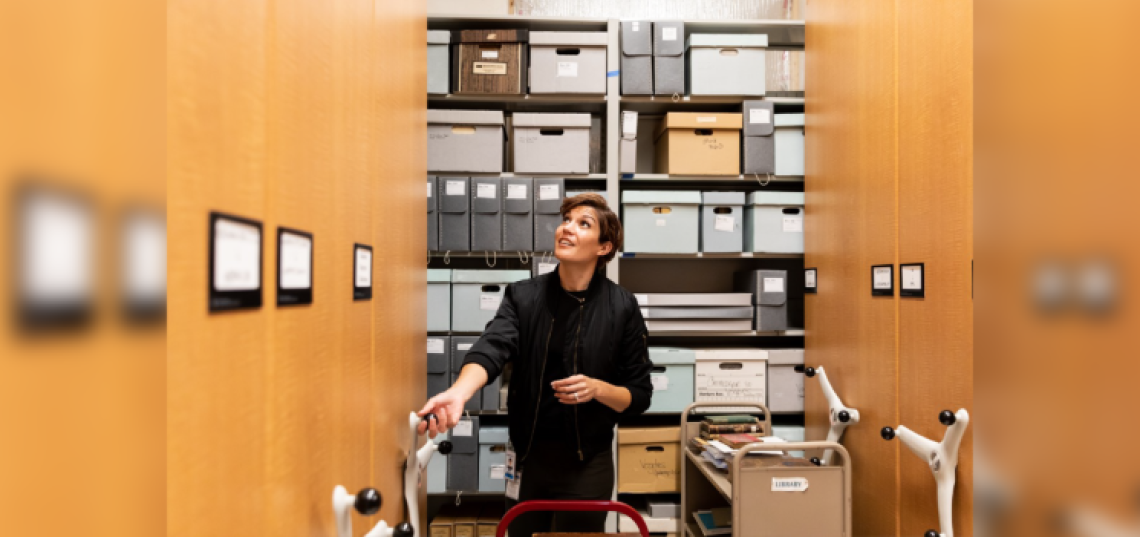
In December, Arie Hammond MI’21 completed the Master of Information program and is looking forward to her May graduation. A San Diego native with a passion for conservation and biodiversity, Arie specializes in information behaviors and technologies. With a background in digital libraries, archives, and rare books, she joined the San Diego Natural History Museum (The Nat) in September 2021 with plans to focus on digitizing resources and diversifying audiences.
She has worked and volunteered at the San Diego Zoo Wildlife Alliance Library, assisted with environmental children’s libraries in Vietnam through WildAct, and served on the technology committee of Wildlife Insights. She focuses on digital libraries as well as digitization and data, and she organized the Camera Trap Technology Symposium, sponsored by Rutgers, San Diego Zoo Global, Microsoft, and Google. Educated at the University of California, San Diego and Rutgers, Arie has published articles on informal information behaviors and the adoption of new technologies to manage institutional information.
SC&I: What led you to the Master of Information program at SC&I?
AH: My background is in literature, and after my undergrad studies, I worked in a bookstore, but there were many things that they did there (like removing seating for customers) that I disagreed with. Each time the owners said, “This isn’t a library,” it made me start considering a career in library science. Before I decided to get my master’s degree in the subject, I took classes at a local community college to see if it was a good fit. That helped set me up for the MI program because I felt pretty well-versed in the topics before entering. Rutgers was my first choice from the beginning! There aren’t any suitable programs in San Diego, so I had to go to school online, but I didn’t want to take the easy route. I wanted to go to a rigorous school that would make me the best librarian I could be, specifically one specializing in information behavior. For me, SC&I was the perfect fit.
SC&I: Tell us about your current position at The Nat and SC&I’s influence on your work.
AH: As the sole librarian in a small special library, I work on technology, public services, rare books, and archives equally. It’s enjoyable to have such varied work, and the people, research, and specimens at the San Diego Natural History Museum are fascinating. Almost everything I do is informed by my experience with SC&I, from looking at information behavior (how different people or departments prefer to engage with information) to analyzing data about my collections to cataloging unique items (like mukluks). My experience helped me blossom into who I am as a person and as an information scientist and librarian. I’m so grateful to have been able to be a part of it.
SC&I: What faculty members and courses have impacted you most?
AH: I received profound support and encouragement from Professor of Library and Information Science Michael Lesk. Early in his data curation course, I approached him with a massive amount of data that I needed to curate; he let me organize a team of fellow MI students to help. He had complete confidence that I could tackle such a project, and it ended up growing into an entire symposium at Google, none of which would have happened if Professor Lesk hadn’t supported me that first day. I’m also grateful to Associate Professor of Practice, Library and Information Science Marc Aronson for his eye-opening course on children’s literature, Associate Teaching Professor Anselm Spoerri for introducing me to programming in Introduction to Information Technologies, and Assistant Professor of Library and Information Science Gretchen Stahlman for her truly engaging Organizing Information course.
SC&I: What sets SC&I’s Master of Information program apart?
AH: The MI program is incredibly leading-edge. It pushed me to learn programming and taught me how to work with big data and manage projects. My courses embraced issues of power, social justice, and intersectionality. This exposure has set me up to be at the forefront of issues within my field instead of just a participant, which is incredible. Also, I felt deeply connected to my instructors and the program even though I was an entire continent away. As we all know, an online program can feel a bit impersonal at times, but I always felt welcome as a part of the larger SC&I community. It’s very apparent that the faculty and staff consciously create a strong community for online students. Having personal connections with professors, students, and staff has enabled me to enter my profession with deep links that span the country.
SC&I: What advice do you have for SC&I’s current and incoming MI students?
AH: Get to know your professors, visit the campus at least once if you can, and don’t be afraid to attend conferences or submit your papers to academic journals. Your voice is essential and helps make our profession better. Also, reach out to people in the field. Every librarian I have ever sent a question to, including those at the Smithsonian and Library of Congress, and support staff at publishing companies, has been more than happy to help, and I have made many lasting professional relationships and friendships that way.
Photo: Courtesy of Arie Hammond MI'21
